Employee monitoring ethics can be a useful tool but there is a fine line between keeping things productive and invading someone’s privacy. You need to follow employee monitoring ethics to find the right balance, so everyone feels respected and stays on task.
This article looks deep into that balance. We won’t just tell you whether it is good or bad – we will give you 10 practical strategies to manage this aspect of modern work environments and use this tool for the right reasons, not just for the sake of watching.
What Are Common Around Employee Monitoring Ethics
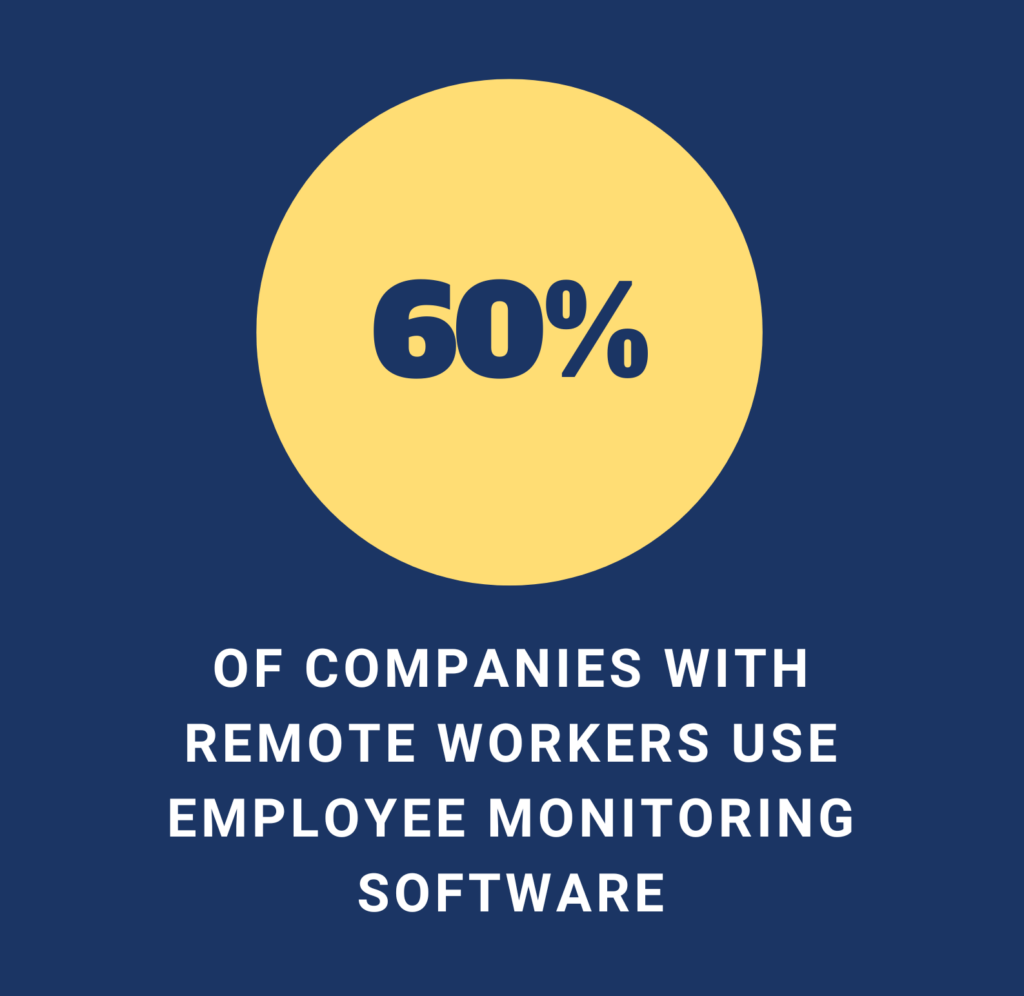
While 60% of companies with remote workers use employee monitoring software, it can be a double-edged sword. Sure, it promises more productive employees but it raises serious ethical concerns that can have serious repercussions for your company culture and team’s well-being. Let’s look into 5 of the biggest issues you should be aware of:
1. Invasion of Privacy
Imagine you are working on a report, then you check a personal social media feed for a quick break. With employee monitoring technology, that seemingly harmless break is now data.
Employees have a reasonable expectation of privacy, especially for personal activities on work devices during breaks. Constant monitoring creates a sense of unease and can feel like an intrusion into their personal work style and habits.
2. Misuse of Collected Data
Employee monitoring software collects a vast amount of data. But what happens to it? If proper protocols aren’t in place, someone might misuse this data. It could be used for purposes beyond productivity, like building employee profiles or even making disciplinary decisions based on incomplete information.
3. Deterioration of Employee Morale
Micromanagement is a perfect way to kill morale. Excessive monitoring sends a clear message: “We don’t trust you to get the job done.” This lack of trust can breed resentment and disengagement. Employees who feel like they are being watched over their shoulders are less likely to take initiative, experiment with new ideas, or go the extra mile.
But it is not just employees who suffer. 75% of customers prefer to do business with brands that personalize their experiences. When employees are micromanaged, they are less likely to deliver that consistent, personalized touch that keeps customers happy. Remember, happy employees mean happy customers, and that is a recipe for success.
4. Trust Issues
Millennials and Gen Z, who control over $1 trillion in spending power, are increasingly concerned about a company’s ethics. This means they not only want to work for but also buy from companies that prioritize trust and transparency. When you monitor employees excessively, it breaks down that trust.
They start questioning your motives and wondering if you value their work or just their activity level. If employees feel like they can’t take a short personal break or browse a harmless website without being scrutinized, it creates a them-vs-us mentality.
5. Discrimination and Bias
Workplace monitoring can be a breeding ground for bias. If not carefully designed and monitored, algorithms used in the software can pick up on subtle cues that show unconscious biases and unfairly penalize certain employees.
For example, an employee who spends more time researching solutions online might be flagged as unproductive, when in reality, their research produces better outcomes.
Employee Monitoring Ethics: 10 Proven Strategies To Do It Right
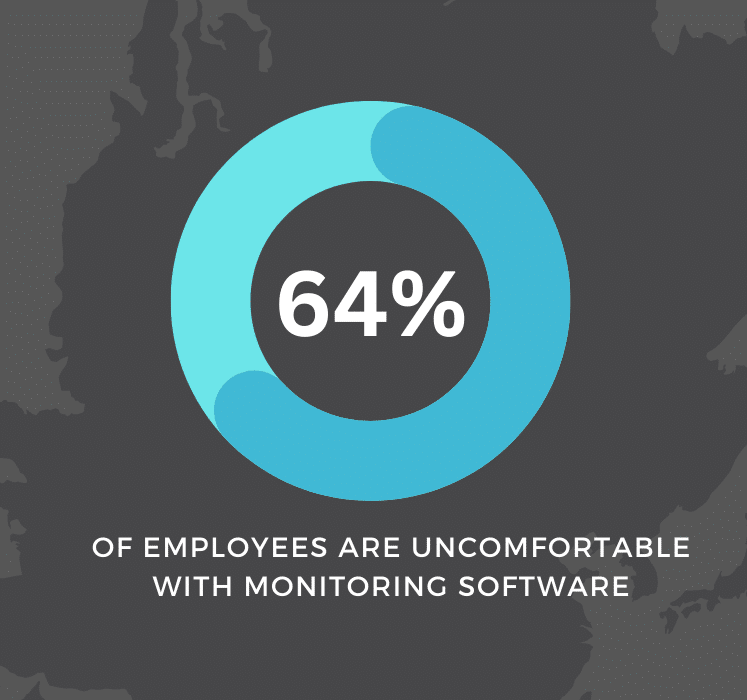
Monitoring employees is a tightrope walk between efficiency and ethics. You want to make sure company resources are used appropriately but with 64% of employees already uncomfortable with monitoring software, you also don’t want to create a hostile work environment.
Keep a close eye on the action points we will provide for each strategy – they will make a big difference in your results.
I. Define Clear Employee Monitoring Ethics Policy & Acceptable Use Guidelines
Employee monitoring can be a tricky subject, especially with the rise of remote work. With an estimated 32.6 million Americans projected to be working remotely by 2025, clear expectations around monitoring are more important than ever. You can achieve the balance by setting those expectations from the very beginning. Here’s how to do it right:
- Your employee monitoring ethics policy should be a straightforward document written in plain language. Avoid legalese and technical jargon. Employees should understand exactly what kind of monitoring is happening and why.
- Write a detailed document outlining exactly what types of employee activity are monitored. This could include work emails, internet browsing history, computer applications used, and even company-issued phones.
- Be specific. Don’t use vague terms like “electronic employee communications.” Spell out what “electronic employee communications” means in your company’s context (emails, instant messages, company chat platforms, etc.).
- Make it clear that employees’ personal data like private emails or messages will not be accessed unless there is a legitimate legal reason.
- Outline data storage and access practices. How long will employee data be stored? Who has access to it? Be transparent about these details.
- Focus on company property. The policy should emphasize that company computers, phones, and internet connections are for work purposes.
- Employee monitoring ethics laws vary by region. Consult with an employment lawyer to ensure your policy complies with all local regulations.
Define acceptable use of company resources
Clearly define what constitutes acceptable use of company resources like computers and internet access.
- List acceptable websites and applications. If certain websites or apps are off-limits during work hours, provide a clear list.
- Define acceptable online behavior. Outline expectations for professional conduct in emails, work chats, and even social media use if it can impact the company.
- Set clear consequences. What happens if someone violates the policy? Outline a fair disciplinary process.
While clear acceptable use guidelines are important for any company with employee monitoring, they are especially essential for travel deal companies like Going. With the travel and tourism industry being a $1.9 trillion market, the competition is fierce.
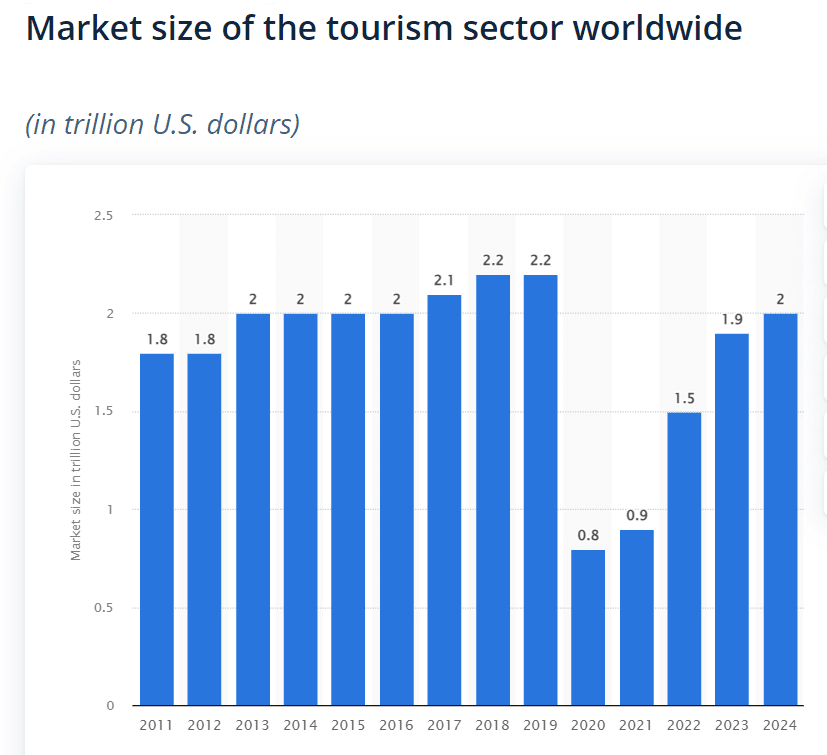
Image source: Statista
They need to be active on social media platforms all the time to stay on top of travel trends, partner with travel bloggers, monitor competitor pricing, and even engage with potential customers directly. So using social media and similar platforms is totally acceptable in this industry.
Also, in the travel industry, reputation is everything. Today’s socially aware customers will do business with a company they trust. When the business is transparent about employee monitoring ethics, it shows customers that they respect their employees’ privacy, which helps build that trust.
However, businesses in a highly regulated elderly care niche like MedicalAlertBuyersGuide need a much stricter policy on social media and similar websites. While some social media platforms can help with content promotion or community engagement, they are not part of most employees’ main duties.
The site’s credibility and user trust depend on providing accurate and up-to-date information. For this, their employees need to access specialized sources that aren’t available to the public. Social media, while useful for promotion, is not a reliable source of medical information. Instead, the business can include access to specific medical journals, industry publications, and government health resource websites (.gov).
II. Tell Employees What Is Monitored & Its Benefits
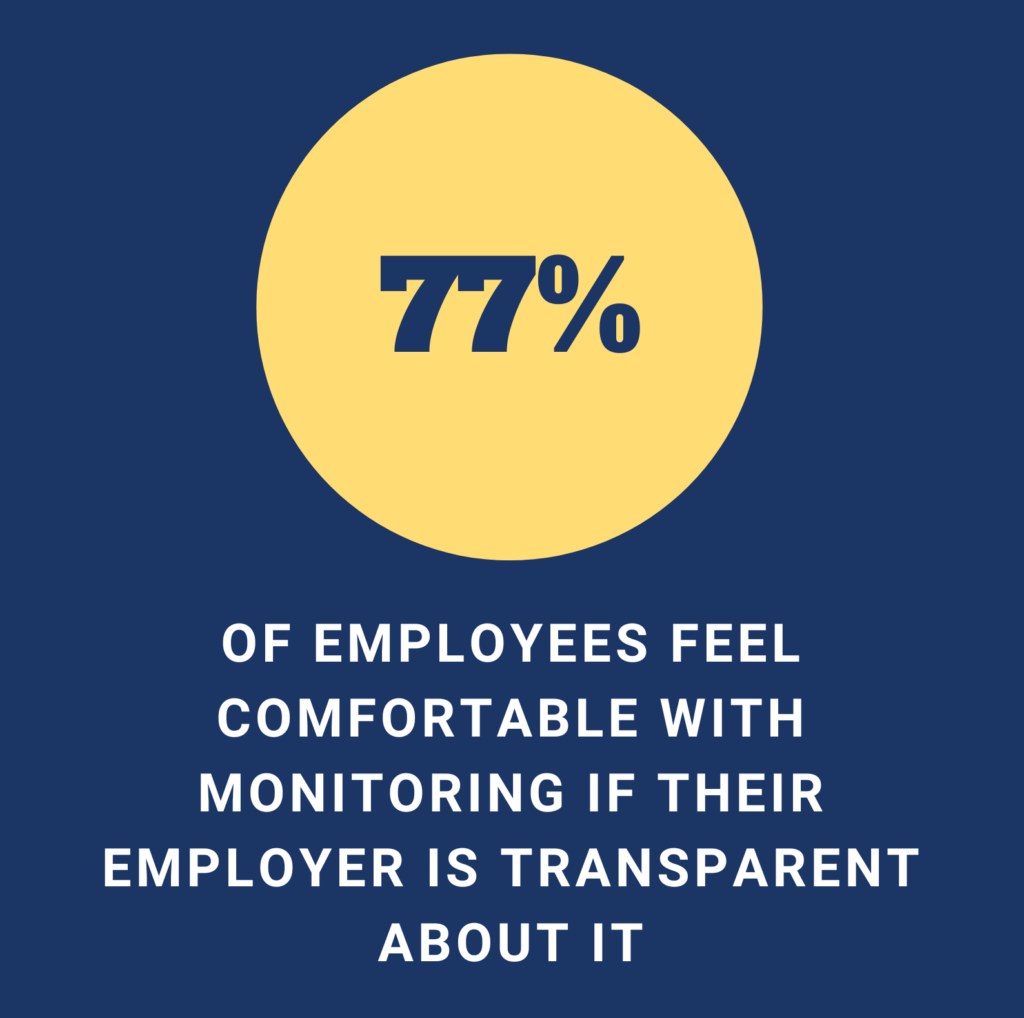
Having a clear policy is important but it’s only half the battle. 77% of employees feel comfortable with monitoring if their employer is transparent about it. So it’s time to have an open and honest conversation with your employees about what is being monitored and why. This is how to do it:
- Schedule town halls or team meetings. Gather your employees and explain the specifics of your employee monitoring ethics practices. Don’t rely solely on a written policy – hearing it directly from you builds trust.
- Don’t just say “We’re monitoring you.” Clearly explain the reasons behind your employee monitoring ethics efforts.
- Frame employee monitoring ethics systems as tools to improve productivity and efficiency, not a way to catch someone slacking off. Highlight how monitoring can help identify areas for training or streamline workflows.
- Be specific about what is tracked. Explain exactly what data is being collected – is it website visits, work hours, or application usage? Transparency builds trust.
- Acknowledge that employees might have privacy concerns and address them head-on. Explain how their data is secured and how long it’s stored. Reiterate your commitment to using the data only for legitimate business purposes.
- Open the floor for questions. Encourage employees to ask questions and voice their concerns. Be prepared to address them openly and honestly.
III. Get Employee Consent For Monitoring
A clear policy and open communication are crucial, but ethical employee monitoring goes a step further: getting employee consent. Here’s how to approach it:
- Employee consent laws vary by region. Consult with an employment lawyer to understand your area’s specific requirements. Some regions require written consent, while others allow for implied consent through policy acknowledgment. We will discuss this later in the article.
- If written consent is required, create a straightforward consent form. It should outline the types of data being monitored, the purpose of monitoring, and how long data will be stored.
- Don’t ask for blanket consent to monitor everything. Be specific. If you are monitoring work emails, get consent for email monitoring. Need to track website visits? Obtain consent for that purpose.
- Be upfront about how employee consent is used. Will it be included in an electronic agreement they sign when logging into company systems? Will it be a separate document they acknowledge?
- While consent is important, provide a clear and easy opt-out option for employees who are uncomfortable with certain monitoring practices.
IV. Train Managers On Ethical Monitoring Practices
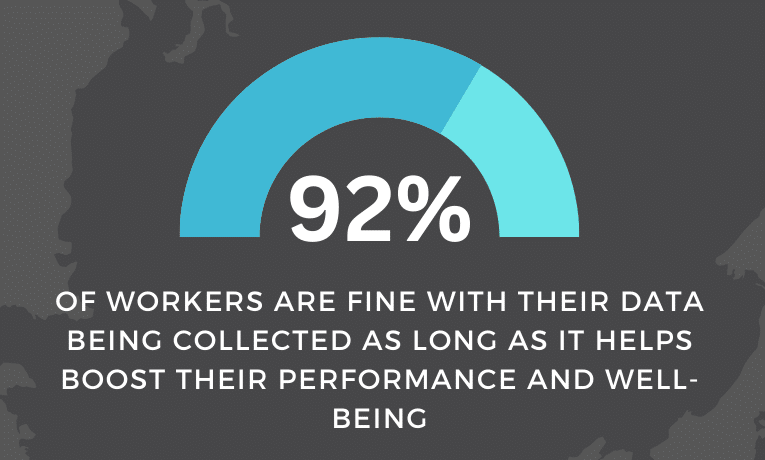
92% of workers are fine with their data getting collected as long as it helps boost their performance and well-being or offers some other personal perks. But to get the most out of monitoring and building trust with your team, it all comes down to your managers. Here’s how to train them to be champions of employee monitoring ethics:
- Make sure your managers understand the importance of clear communication. Managers should be prepared to answer employee questions openly and honestly.
- Train managers to explain the monitoring’s purpose. Is it to ensure data security? Improve customer service interactions? Help employees be more efficient? When employees understand the goals, they will see monitoring as a positive tool.
- Vague guidelines breed confusion. Managers should clearly define what acceptable and unacceptable online behavior looks like for different roles. Is it okay to check social media for a few minutes during a break? What websites are off-limits entirely? Specificity is essential.
- Monitoring shouldn’t be about micromanaging every keystroke. Train managers to look at the bigger picture. Are employees meeting deadlines? Are customer satisfaction ratings high? With 89% of consumers choosing your competitor after a bad user experience, you can’t afford to have disengaged employees creating those bad experiences. So focus on results, not just activity on the computer screen.
- There is a line between monitoring work activity and invading employee privacy. Train managers to understand what data is relevant and what isn’t. There is no need to monitor personal emails or social media accounts unless there’s a specific, legitimate reason (like a company investigation).
V. Focus On Monitoring Results Over Activity
Employee monitoring tools can track a lot – websites visited, keystrokes typed, hours logged in. But the raw numbers don’t tell the whole story. This is how to shift your focus from simply monitoring activity to analyzing results:
- Instead of monitoring every email sent, focus on whether projects are completed on time and within budget. This gives a clearer picture of actual productivity.
- Don’t get caught up in how many hours someone spends working. Track the quality of work produced and focus on the end result, not just the time spent getting there. If they deliver a polished report or a functional piece of code, that should be good enough.
- Use monitoring data to identify areas where employees need help, not to spy on their every move. If someone is struggling to meet customer expectations, offer additional resources or training instead of jumping to conclusions. Around 48% of buyers end up purchasing the wrong product or service simply because they weren’t properly guided. Empowered employees who understand your products can connect with customers on a genuine level.
- Define what “good” results look like for each role. Is it a certain number of sales calls completed or a specific error rate on tasks? Clear expectations make it easier to assess results objectively.
- When results fall short, focus on finding solutions together with your employees. The monitoring data provides a starting point but the real value comes from open communication and collaboration to improve performance.
VI. Use Data Analytics To Identify Patterns, Not Individuals
Businesses can lose up to 40% of their productivity because employees are surfing the internet for non-work-related things. While employee monitoring data can provide useful insights to fix this issue, going through individual details can be overwhelming. Here’s how to use data analytics for a more ethical and productive approach to monitoring employee productivity:
- A single employee having a slow day doesn’t mean a problem. Use data analytics to identify patterns over time. Maybe entire teams are struggling to meet deadlines on a specific project. This helps pinpoint areas for improvement, not single out individuals for minor bumps in activity.
- Don’t get lost in tracking every keystroke. Use data analytics to see how teams are functioning as a whole. Are there bottlenecks in workflows? Is communication hindering progress? Focus on the bigger picture to identify systemic issues.
- Instead of constantly monitoring every data point, set up automated alerts to notify you of significant deviations from normal patterns. This could be a sudden drop in productivity for a usually high performer or a spike in errors on a particular task.
- Don’t just react to negative trends. Use data analytics to identify areas where employees need additional resources or training. For example, if a team is struggling with a new software program, offer targeted training sessions to boost their skills.
VII. Limit Monitoring To Work-Related Activities & Company Property
When you set clear boundaries and focus on securing work information, you can effectively monitor employee productivity without infringing on their personal privacy. This is how to limit monitoring to work-related activities and company property:
- Be specific about what activities qualify as work-related. Does it include work email and documents only? Company communication apps? If employees can answer work calls on their phones, is all phone activity monitored? Define these parameters clearly in your policy.
- Similarly, clearly outline which devices are considered “company property.” This could include laptops, desktops, and smartphones issued to employees for work purposes.
- If allowing personal devices for work (BYOD), establish limitations on what monitoring can occur. Focus on work apps and data accessed through company accounts, not personal browsing history or private messages.
- If you plan to monitor activity on personal devices, explain what data is collected and how it is used. This builds trust and avoids surprising employees later.
VIII. Implement Anonymization & Data Protection Measures

Image source: Ekran System
Ethical monitoring goes hand in hand with robust data protection. It builds trust within your team and helps you avoid potential legal pitfalls. This is how to make it work:
- Not all data needs to be personally identifiable. For instance, if you are looking at overall trends in app usage, employee names are irrelevant. Strip out personally identifiable information whenever possible to protect employee privacy.
- Grant access to employee monitoring data only to those who need it for legitimate business purposes. Minimize the number of people who can see individual employee information.
- Decide how long you will store employee monitoring data. There is no need to hold onto data indefinitely. Establish clear guidelines for data retention and deletion to ensure privacy is maintained.
- Make sure the data collected through employee monitoring is encrypted, both at rest and in transit. Invest in strong data security measures like encryption and firewalls to protect it from unauthorized access or breaches.
While these transparency and data protection practices are important in most businesses, they may not be as central as in online job boards like Prosple that rely on social capital – trust and positive relationships between job seekers and employers using the platform.
Prosple relies heavily on its reputation for trustworthiness. If job seekers or employers suspect a lack of transparency in employee monitoring, it can raise concerns about their data security and the overall integrity of the platform.
After all, the data they handle isn’t just numbers; it is linked to people’s careers and futures. Transparency around how employee monitoring protects this sensitive data shows a commitment to responsible handling of human capital.
IX. Collect Employee Feedback & Respond Immediately To Their Concerns
Remember, employee monitoring is happening to your employees, not for them. So you have to work with them. When they feel heard and respected, they will be engaged and productive. Here’s how to do it:
- Don’t rely on a single survey. Set up multiple channels so that employees can provide feedback on your monitoring practices. This could include anonymous surveys, focus groups, or one-on-one meetings.
- When employees express concerns about monitoring, listen actively and without judgment. Take their feedback seriously and show them you are willing to adapt.
- Don’t leave employee concerns hanging. Address them promptly and transparently. Explain your reasoning behind the monitoring practices and be open to making adjustments if necessary.
- Don’t get stuck justifying every aspect of your monitoring program. Focus on finding solutions that address employee concerns while still meeting your business needs.
X. Regularly Review & Update Monitoring Policies
Employee monitoring is a dynamic field. Technology evolves and so should your practices. This is how to regularly review and update your monitoring policies to stay ethical and effective:
- Schedule regular reviews – quarterly or bi-annually – to check if it is working well and following current laws.
- Employment laws about monitoring can change quickly. Stay informed about any updates or new regulations that impact your monitoring practices.
- New technologies offer more sophisticated monitoring tools. Evaluate new options but prioritize those that enhance privacy and data security.
- Remember, your employees are using your monitoring system every day. Incorporate their feedback from surveys and focus groups into your review process.
- Don’t keep employees in the dark. Clearly communicate any changes you make to your monitoring policy and explain the reason behind them.
Understanding The Laws & Regulations Related To Employee Monitoring & Privacy
As we mentioned earlier, employee monitoring and privacy walk a tightrope in the workplace. Companies look to ensure productivity and security, while employees have a right to privacy expectations. You should understand the complex web of laws and regulations governing this space. Here’s a deep dive:
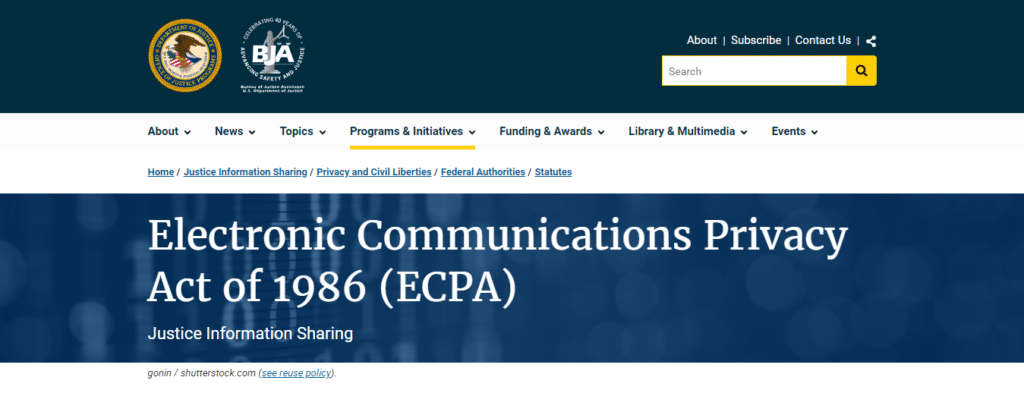
Image source: US DOJ website
The Electronic Communications Privacy Act (ECPA) of 1986 lays the groundwork for federal regulations. It differentiates between 2 major areas:
Stored Communications Act (SCA)
This governs electronic communications stored on company servers or cloud platforms. Employers generally have broader leeway to monitor these communications, especially emails and documents, as long as they can demonstrate a legitimate business reason.
This could include ensuring compliance with company policies, preventing harassment, or safeguarding confidential information.
Federal Wiretap Act
This applies to real-time electronic communications like phone calls or instant messages. The act prohibits interception without a warrant unless one party consents (often the employer with a company phone). However, exceptions exist for monitoring extensions or calls made on company equipment for business purposes.
Beyond the ECPA, there are additional federal considerations:
- National Labor Relations Act (NLRA): This protects employees’ right to engage in concerted activities about wages, hours, and working conditions. Employers cannot monitor communications solely to quash these rights.
- Fair Labor Standards Act (FLSA): The FLSA dictates employee compensation for work hours. Employers can monitor work time for accurate record-keeping for payroll purposes.
While the ECPA sets a baseline, several states have enacted stricter regulations:
- California: The California Consumer Privacy Act (CCPA) and the forthcoming California Privacy Rights Act (CPRA) give employees significant rights to access and control their personal information collected through monitoring.
- Connecticut, Delaware, New York, and Texas: These states require you to get written consent before monitoring electronic communications.
- Other States: Many states have privacy laws that indirectly impact employee monitoring. These can address video surveillance, geolocation tracking, or social media monitoring of personal accounts.
Remember, this is not an exhaustive list, and you should consult with legal counsel to make sure you are following all the laws and regulations in your area.
WebWork: The Ethical Balance Of Time Tracking, Productivity, & Employee Monitoring
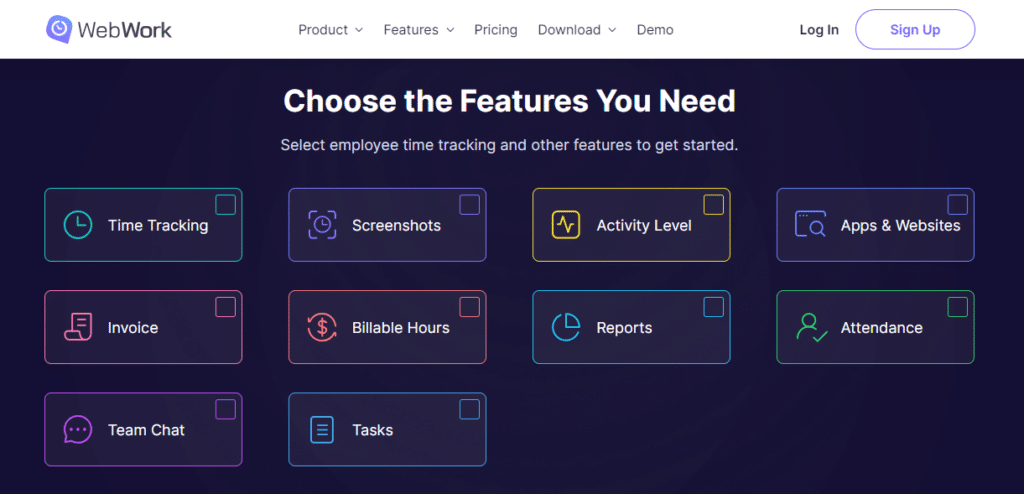
When it comes to employee monitoring, choosing the right tool is often the most important factor. You want something that helps you understand how your team works and identify areas for improvement, but also ensures you are doing it ethically and transparently.
WebWork is ideal for businesses of all sizes that need to track time, manage projects, and improve employee productivity. It is a great solution if you have remote employees or want to get better visibility into how your teams are working. Using our tool, people have seen productivity jump by 25% and revenue go up by about $800 each month on average.
Here are the key features that can help you get the same results while promoting ethical monitoring:
- Track time spent on tasks and projects with desktop, mobile, web, and Chrome extension options.
- Take screenshots of employee activity to ensure they are working and have proof of their work.
- Monitor attendance and set up shifts to track employee work hours.
- Gain insights into employee productivity with features like app & website tracking and activity level monitoring.
- Manage projects, assign tasks, and track progress all in one place.
- Generate invoices based on tracked hours and set hourly rates.
- Improve team communication with built-in chat features.
Conclusion
The notion of using employee monitoring as a tool for micromanagement is outdated. With employee monitoring ethics in place, your team will understand the “whys” and “hows” of monitoring and become active participants. Choose transparency, choose trust, choose ethical monitoring – and watch your company soar.
WebWork is a time-tracking software designed with both employer and employee needs in mind. It goes beyond simple monitoring by providing a platform to manage projects, tasks, and invoicing, all while ensuring clear communication and transparency. Start your 14-day free trial now and see the difference.
